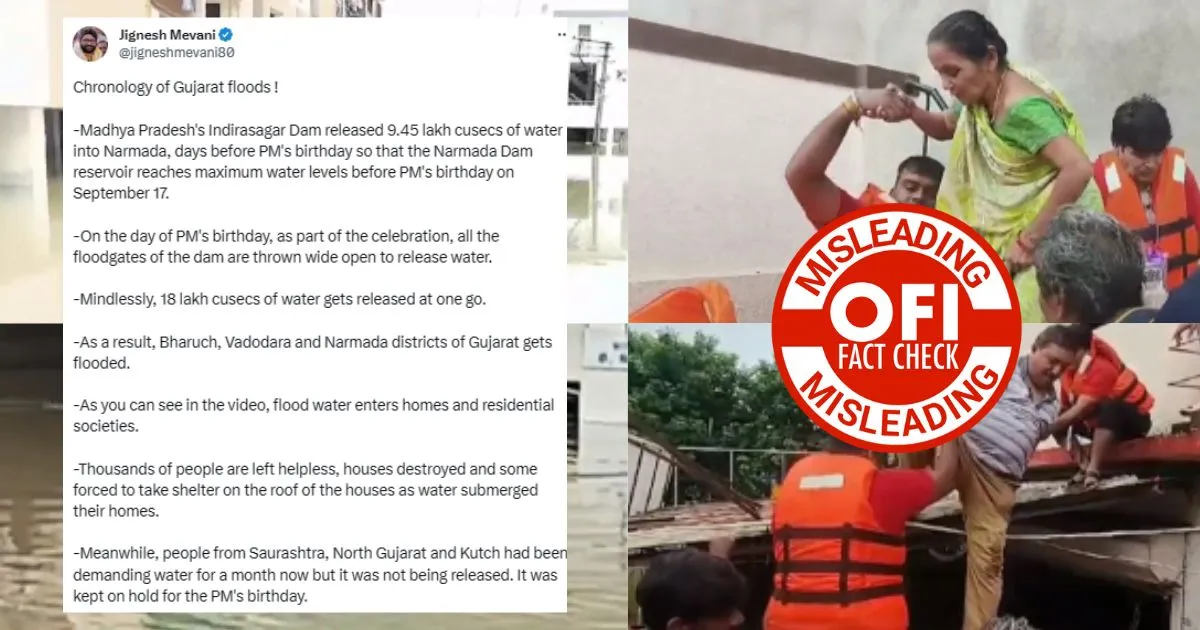In the midst of the flooding crisis in Gujarat, Jignesh Mevani, a member of the Indian National Congress party and the current representative of the Vadgam constituency, took to the social media platform X (formerly known as Twitter) to make some bizarre claims. In a lengthy tweet (Archived link), Mevani claimed that all floodgates of a dam were intentionally opened wide to release water in order to commemorate the Prime Minister’s birthday on September 17. He went on to add that this action led to flooding in Bharuch, Vadodara, and Narmada districts of Gujarat, while people from Saurashtra, North Gujarat, and Kutch had been requesting water release for a month without success. He concluded his tweet by stating that this flooding should not be viewed as a natural disaster but rather as a man-made disaster orchestrated to commemorate the “Messiah.”
Another account, going by the handle name Nayini Anurag Reddy (Archived link), has made the same claim, referring to the flood as a man-made disaster. According to this account, despite the heavy rainfall in Madhya Pradesh, water from the dam was intentionally released to mark Prime Minister Modi’s birthday. The claim suggests that the BJP government had deliberately withheld water in the preceding days, waiting for the occasion of the Prime Minister’s birthday to release it.
The Ambedkarite account @/ProfRavikantK (Archived link) sharing the Indian Express report wrote, “Man-made disaster’? Shut up! Why even have a democracy if you can’t flood 3–4 towns to have the perfect photo-op to wish the PM a happy birthday!”
Additionally, an account by the name of Man Aman Singh Chhina (Archived link), followed by the propaganda fact-checker Mohammad Zubair, who shared an Indian Express report, labeled this action as a criminal offense.
Furthermore, the account of Aqeel Hussain Masalawala (Archived link), who according to his bio is a ground worker for INC, also asserts that the flooding in Gujarat is a result of a man-made disaster.
Also Read: PM Modi’s Appreciation for Chandrayaan 3 Landing Misleadingly Tied to Asia Cup Victory
Fact Check
Myth vs. Facts: The Chronology of Flood Control at Sardar Sarovar (16-18 SEPT)
There has been a continuous buzz about whether the recent devastating floods in Gujarat’s Bharuch and Ankleshwar towns were entirely human-induced. Could this disaster have been prevented? Did engineers of the Sardar Sarovar Narmada Nigam Limited (SSNNL) intentionally release water from the dam to achieve Full Reservoir Level (FRL) on September 17th? Were there mindless water releases later, leading to severe downstream consequences?
Now, let’s delve into the events of September 16-18 and dispel the misconceptions surrounding them. In our fact-checking report, we came across a tweet (Archived link) by India TV journalist Nirnay Kapoor, providing a detailed and fact-based explanation for the water release from the Indirasagar Dam.
According to Kapoor’s finding, between September 15th and 17th, heavy rainfall occurred in districts within the Narmada basin in Madhya Pradesh and Maharashtra. This led to an influx of water into the upstream region. Due to these factors, water release downstream began as per the emergency situation, starting on September 16th. The water released from the dam upstream takes approximately 20 hours to reach Sardar Sarovar. Indira Sagar dam, upstream of Sardar Sarovar, released 6.67 lakh cusecs on September 16th at 7 AM. By 11 AM, it reached 5.79 lakh cusecs, and eventually peaked at 21.72 lakh cusecs on the same day.
Some may question why engineers didn’t release water from Sardar Sarovar to achieve the FRL of 138.68 meters on September 17th. However, this narrative overlooks the fact that on September 16th, when water release began at 10 AM, the dam’s water level was below the FRL, at 136 meters. Therefore, the water couldn’t have been intentionally withheld.
The dam reached FRL on the morning of September 17th due to the continuous rainfall and upstream water inflow. But this was not a result of an engineer’s decision; it was a natural outcome of the inflow. At that time, the water inflow was closely monitored to mitigate downstream flooding.
Moreover, on September 17, the situation remained relatively stable, with controlled flood release. After September 17, the weather system shifted from Madhya Pradesh to Gujarat, reducing the water inflow into the dam. Starting from the evening of September 17th, water releases were carefully managed, and by September 18th, only 6 lakh cusecs were being released.
Now, let’s address why the Riverbed Powerhouse (RBPH) was shut down from September 6th to September 15th. Nirnay explained that during this timeframe, there was notably limited rainfall in the Narmada basin, and the reservoir’s water level was relatively low, at approximately 78%. Given these circumstances, opting to preserve water in the dam rather than producing electricity was a sensible choice to ensure a stable supply for drinking and irrigation purposes.
One might wonder about the electricity generation, but the fact remains that there was no substantial rainfall or water inflow during this period, and dam levels remained critically low. Thus, prioritizing water conservation over power generation was crucial to meet the drinking and irrigation water demands.
In conclusion, the events leading to the release of water from the Sardar Sarovar dam were driven by natural factors, rainfall, and upstream inflow, rather than any deliberate human intervention. The decisions made were essential for minimizing the impact of flooding downstream and ensuring the availability of water for various needs in Gujarat.
| Claim | Flood in the area of Bharuch and Ankleshwar is man-made disaster |
| Claimed by | Jignesh Mevani and others |
| Fact Check | Misleading |
The goal of the Only Fact Team is to provide authentic news facts and debunk lies to safeguard readers’ interests.
Dear Readers, we are working to debunk fake news which is against India. We don’t have corporate funding like others. Your small support will help us grow further.
If you like our work, support and donate us using the Livix Media Foundation QR code.
Jai Hind!









